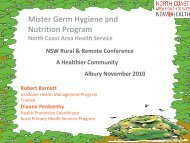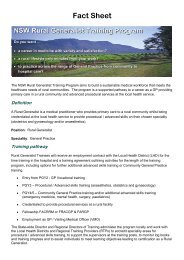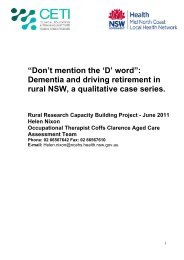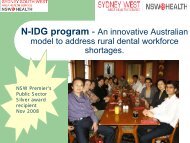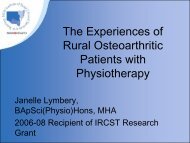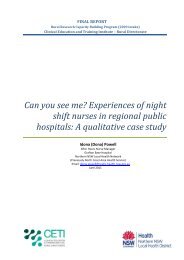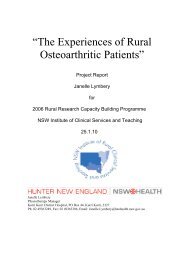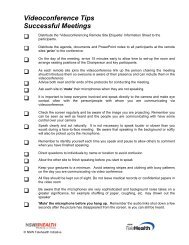AIHW Powerpoint presentation - Home - Health Education and ...
AIHW Powerpoint presentation - Home - Health Education and ...
AIHW Powerpoint presentation - Home - Health Education and ...
Create successful ePaper yourself
Turn your PDF publications into a flip-book with our unique Google optimized e-Paper software.
A report on men’s health in<br />
regional <strong>and</strong> remote Australia<br />
Lisa Thompson <strong>and</strong> Sally Bullock<br />
NSW Rural <strong>and</strong> Remote <strong>Health</strong> Conference<br />
4–5 November 2010
The <strong>AIHW</strong> <strong>and</strong> rural health reporting<br />
The report:<br />
<strong>AIHW</strong> 2010. A snapshot of men’s health in<br />
regional <strong>and</strong> remote Australia.<br />
Rural health series no. 11. Cat. no. PHE 120.<br />
Canberra: <strong>AIHW</strong><br />
Other rural health publications:<br />
www.aihw.gov.au/ruralhealth/publications.cfm
Today’s <strong>presentation</strong><br />
• Why men in regional <strong>and</strong> remote areas<br />
• Measuring remoteness<br />
• Demographics<br />
• <strong>Health</strong> risk factors<br />
• <strong>Health</strong> conditions<br />
• Changes in men’s health status over time<br />
• The general practice setting<br />
• Mortality<br />
• Mapping mortality across states <strong>and</strong> territories
Why men<br />
• Research has consistently shown a sex differential in<br />
illness <strong>and</strong> mortality.<br />
• Australian men currently have a shorter life expectancy,<br />
higher overall mortality rates <strong>and</strong> are more likely to<br />
experience a number of health problems (e.g. cancer,<br />
diabetes <strong>and</strong> cardiovascular disease).<br />
• In May 2010, the Federal Government launched<br />
Australia’s first National Male <strong>Health</strong> Policy, highlighting<br />
the health challenges facing Australian males.
Why men in regional <strong>and</strong> remote areas<br />
• One-third of males (3.3 million) live outside Major cities.<br />
• Work, location <strong>and</strong> lifestyle create unique health issues.<br />
• Strong relationship between poor health <strong>and</strong> social <strong>and</strong><br />
economic disadvantage:<br />
– Regional <strong>and</strong> remote areas contain a higher proportion<br />
of socioeconomically disadvantaged people <strong>and</strong> a<br />
higher proportion of people who identify as Indigenous.
Measuring remoteness in Australia<br />
• The Australian St<strong>and</strong>ard Geographical Classification<br />
(ASGC) has five main categories for remoteness:<br />
Regional<br />
Remote<br />
Male pop<br />
distribution<br />
Major cities<br />
(MC)<br />
Inner<br />
regional<br />
(IR)<br />
Outer<br />
regional<br />
(OR)<br />
Remote<br />
(R)<br />
Very remote<br />
(VR)<br />
68.0% 19.7% 9.6% 1.6% 0.8%<br />
For example Sydney Albury Broken Hill Bourke Wilcannia
Demographics: rural men at a glance<br />
In regional <strong>and</strong> remote areas (compared with Major cities) there are:<br />
• More boys <strong>and</strong> fewer older men<br />
• More lone-person households<br />
• Generally lower levels of education<br />
• Higher rates of employment in primary production<br />
• Lower levels of marriage<br />
• Lower levels of home ownership<br />
• Higher rates of volunteering<br />
Source: ABS Census of Population <strong>and</strong> Housing 2006.
Socioeconomic status by remoteness<br />
Proportion of male population living<br />
in areas classified as low SES<br />
Major cities 27%<br />
Inner regional 46%<br />
Outer regional 62%<br />
Remote 57%<br />
Very remote 77%<br />
Source: ABS Census of Population <strong>and</strong> Housing 2006.
<strong>Health</strong> risk factors<br />
Men in regional/remote areas were more likely than their urban<br />
counterparts to experience chronic health conditions & risk factors.<br />
For example, they were:<br />
- 40% more likely to report daily smoking<br />
- 30% more likely to report risky/high risk alcohol consumption<br />
- 6% more likely to be overweight or obese<br />
- 7% more likely to undertake insufficient exercise<br />
- Less likely to possess an adequate level of health literacy<br />
But more likely to consume recommended serving of vegetables<br />
Source: ABS National <strong>Health</strong> Survey 2004–05; National Drug Strategy Household Survey 2007; ABS ALLS 2006
Selected health conditions, 2004–05<br />
Source: ABS National <strong>Health</strong> Survey 2004–05
Changes in men’s health status over time<br />
<strong>Health</strong> status<br />
Diabetes; osteoporosis<br />
Asthma<br />
Bronchitis<br />
Short-term injury<br />
Long-term condition due to injury<br />
Arthritis<br />
Self-assessed very good/excellent<br />
health<br />
Trend in Major<br />
cities<br />
Trend outside Major<br />
cities<br />
Source: ABS National <strong>Health</strong> Survey 1995, 2001, 2004–05
Men in the general practice setting<br />
• Compared with their urban counterparts, men in regional <strong>and</strong><br />
remote areas were:<br />
- less likely to present with two or more reasons for visiting<br />
- more likely to have a problem that was work-related or chronic<br />
- more likely to see a GP about skin issues<br />
- less likely to see a GP about respiratory <strong>and</strong> digestive issues.<br />
• Higher proportion of encounters with Indigenous males, older<br />
men <strong>and</strong> less with young boys.<br />
Source: <strong>AIHW</strong> analysis of BEACH data 2007.
Male mortality rates increase with remoteness<br />
Compared with men in Major cities, death rates were:<br />
- 8% higher in Inner regional areas<br />
- 14% higher in Outer regional areas<br />
- 25% higher in Remote areas<br />
- 78% higher in Very remote areas<br />
If current death rates remained, 72% of boys born in<br />
Very remote areas could be expected to reach the age<br />
of 65 (compared to 88% of boys in Major cities)<br />
Source: <strong>AIHW</strong> National Mortality Database.
Mortality rates for non-Indigenous men<br />
• Higher mortality in more remote areas is not due<br />
exclusively to the higher proportion of Indigenous males.<br />
• Compared with non-Indigenous males in Major cities,<br />
non-Indigenous male death rates were still 10–20% higher.<br />
A non-Indigenous boy born in a Very remote area in 2006 could<br />
expect to live to 77.7 years (compared to 80.8 years in Major cities)<br />
Source: <strong>AIHW</strong> National Mortality Database.
Mortality from all causes by age<br />
Death rates among young<br />
men (15–24 years) in<br />
regional <strong>and</strong> remote areas<br />
were 83% higher than in<br />
Major cities<br />
Death rates among older<br />
men (65+ years) in<br />
regional <strong>and</strong> remote areas<br />
were 6% higher than in<br />
Major cities<br />
Source: <strong>AIHW</strong> National Mortality Database.
Causes of death<br />
• Cardiovascular diseases were responsible for nearly<br />
one-third of the elevated male death rates in regional <strong>and</strong><br />
remote areas.<br />
• Male death rates due to injury <strong>and</strong> poisoning in Very remote<br />
areas were 3.1 times as high compared with Major cities.<br />
- MVA (114% higher), assault (31% higher), suicide (33% higher)<br />
• Male death rates from diabetes were 1.3 times as high in<br />
Inner regional areas <strong>and</strong> 3.7 times as high in Very remote<br />
areas as compared with males in Major cities.<br />
Source: <strong>AIHW</strong> National Mortality Database.
Mapping mortality: New South Wales<br />
In 2004–06, male death rates<br />
in NSW generally increased<br />
with remoteness.<br />
Compared with Australian<br />
Major cities, male death rates<br />
were over 20% higher in<br />
Dubbo, Lachlan, Bathurst-<br />
Orange, Central Murray <strong>and</strong><br />
the Southern Tablel<strong>and</strong>s.<br />
Source: <strong>AIHW</strong> National Mortality Database.
Mapping mortality: Queensl<strong>and</strong><br />
In 2004–06, male death rates<br />
were over 20% higher than<br />
Australian Major cities in north<br />
<strong>and</strong> west Qld.<br />
Compared with Australian<br />
Major cities, male death rates<br />
were significantly lower in<br />
Moreton <strong>and</strong> similar in<br />
Sunshine Coast, Hervey Bay,<br />
Gladstone <strong>and</strong> Mackay.
Mapping mortality: Western Australia<br />
In 2004–06, male death rates<br />
were over 20% higher than<br />
Australian Major cities in most<br />
of eastern <strong>and</strong> northern WA.<br />
Compared with Australian Major<br />
cities, male death rates were<br />
lower in North Metropolitan<br />
Perth <strong>and</strong> Vasse <strong>and</strong> similar in<br />
the south <strong>and</strong> west.
Mapping mortality: South Australia<br />
In 2004–06, male death rates<br />
were over 20% higher than<br />
Australian Major cities in most<br />
of northern <strong>and</strong> western SA.<br />
Compared with Australian<br />
Major cities, male death rates<br />
were lower in Southern<br />
Adelaide <strong>and</strong> similar in the<br />
south-east.<br />
For other states <strong>and</strong> territories (except ACT), see:<br />
www.aihw.gov.au/publications/index.cfm/title/10742
Thank you<br />
Further information:<br />
www.aihw.gov.au/ruralhealth/publications.cfm<br />
Contacts:<br />
lisa.thompson@aihw.gov.au<br />
sally.bullock@aihw.gov.au



